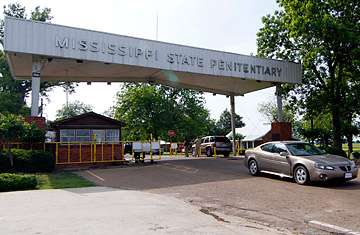
The Mississippi State Penitentiary in Parchman, Miss. on May 19, 2010.
On Monday, May 16, Chris Epps, commissioner of Mississippi's department of corrections, sat at a long conference table, grasping a mound of financial documents. He was preparing to head to the state's penitentiary, an 18,000-acre old cotton farm in the Mississippi River Delta, for the execution of a man convicted of murder nearly two decades ago. Since the mid-1990s, Mississippi has become one of America's most aggressive incarcerators — a difficult feat, in a nation of jailers. Now, Epps is leading Mississippi on an improbable shift: dismantling the prison system. "We've got all these needs" — education, health care — "and spending all this money on corrections," Epps says. "We've got to decide who we're mad with, and who we're afraid of."
Incarceration has been America's primary weapon in the war on crime. That's why in the 80s, Congress passed laws mandating that if you were caught with just 50 grams of crack-cocaine — about 20 packs of sugar — you automatically got a decade in prison. In 1980, according to the Sentencing Project, a Washington-based advocacy group, an estimated 41,000 people were in prison or jail for drug offenses, and by 2003, that population had grown to nearly a half-million. Now, some 2.3 million people — about 1 in every 100 U.S. adults — are incarcerated. Prison overcrowding reached such crisis levels in California that, in May, the U.S. Supreme Court upheld a judicial-panel decision that requires the state to release 46,000 inmates over the next two years.
Nevertheless, the incarceration boom appears to be reversing. Between 2008 and 2009, state prison populations fell slightly, by 0.3%, to 1.4 million, the first such decline since the 70s. There are several reasons for the shift. The first is money. The Great Recession decimated state coffers, and is forcing governments to acknowledge they can no longer afford spending $52 billion a year locking people up. The second reason is demographics: people between 15 and 34 — prime ages for criminal activity — account for about 27% of the American population, compared to about 32% in 1990, near the violent-crime wave's peak.
Those shifts, coupled with the over-saturation of prisons, partly explain why the violent crime rate has dropped to the lowest point in almost 40 years. Between 1997 and 2007, New York State's prison population shrank by 9.4%, or 6,500 inmates, according to the Pew Center on the States, and the state's violent crime rate almost halved. The takeaway, says James Austin, a leading criminal justice expert: "You can cut back on the size of the prison population without having a negative impact on crime."
Epps wants to bring that lesson to Mississippi's prison system. Or, as he puts it, "To not lock up more people." He is 50 years old, very tall, with a drawl that calls to mind an old-school Southern sheriff. The son of educators raised in Tchula, Miss., a nearly all-black town in the heart of cotton country, Epps joined the department as an officer at the state penitentiary at Parchman, managing the movement of inmates between, say, the dentist and dining hall. He rose quickly, and was appointed as the department's chief in 2002, by Ronnie Musgrove, a socially conservative Democratic governor. Two years later, Mississippi's then-new governor, Haley Barbour, a Republican, reappointed him to the job.
